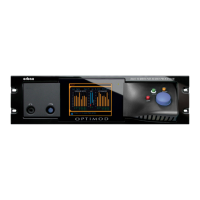2-28
INSTALLATION ORBAN MODEL 8685
inputs are equipped with sample rate converters so no sync reference is
required. (However, there is no downside to locking the sample rate driv-
ing the Penteo to house sync.)
C) Set the 2.0 OUTPUT RATE to 32, 44.1, 48, 88.2, or 96 kHz.
• If you are using I
NTERNAL sync [step (B) above], 48 kHz or 96 kHz are pre-
ferred because their samples are synchronous with the peak-controlled
samples in the processing. If you are using external sync, this special rela-
tionship no longer holds.
• Selecting a 32 kHz output sample rate will automatically set the highest
available audio bandwidth to 15 kHz.
• 2.0
OUTPUT RATE affects the usable range of test tone frequencies. When
2.0
OUTPUT RATE is set to 32 kHz, the highest usable tone frequency is
15 kHz. When
2.0 OUTPUT RATE is set to 44.1 or above, all tone frequencies
are usable.
D) Set the 2.0
OUTPUT WORD LENGTH.
[14], [16], [18], [20], or [24], in bits
The largest valid word length in the 8685 is 24 bits
The 8685 can truncate its output word length to 20, 18, 16 or 14 bits and
can add appropriate dither before the truncation to linearize it (see the
next step).
E) Set the 2.0 OUTPUT DITHER to IN or OUT, as desired.
[In] or [Out]
When this control is set to I
N, the 8685 adds “high-pass” dither before
any truncation of the output word. The amount of dither automatically
tracks the setting of the W
ORD LEN control. This first-order noise-shaped
dither considerably reduces added noise in the midrange by comparison
to white PDF dither. However, unlike extreme noise shaping, it adds a
maximum of 3 dB of excess total noise power when compared to white
PDF dither. Thus, it is a good compromise between white PDF dither and
extreme noise shaping.
To ensure maximum system linearity, it is wise to set this control to I
N.
F) Set 2.0 OUTPUT FORMAT to AES or SPDIF
G) Set 2.0
OUTPUT SOURCE control. The choices are:
• AGC
(stereo enhancement, equalization, and AGC without peak limiting)
• AGC+L
IMIT (stereo enhancement, equalization, AGC, and look-ahead peak
limiting)
• M
ULTIBAND (stereo enhancement, equalization, AGC, and two-band or 5-
Band compression without peak limiting)
• MB+L
IMIT (stereo enhancement, equalization, AGC, two-band or 5-Band
compression, and look-ahead peak limiting).

